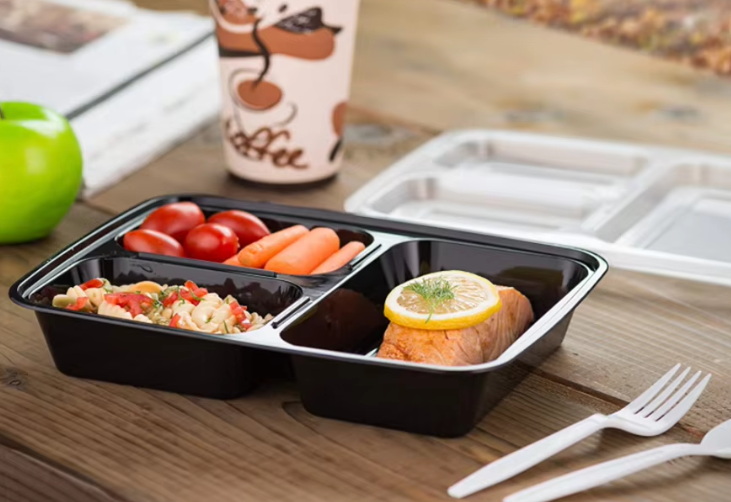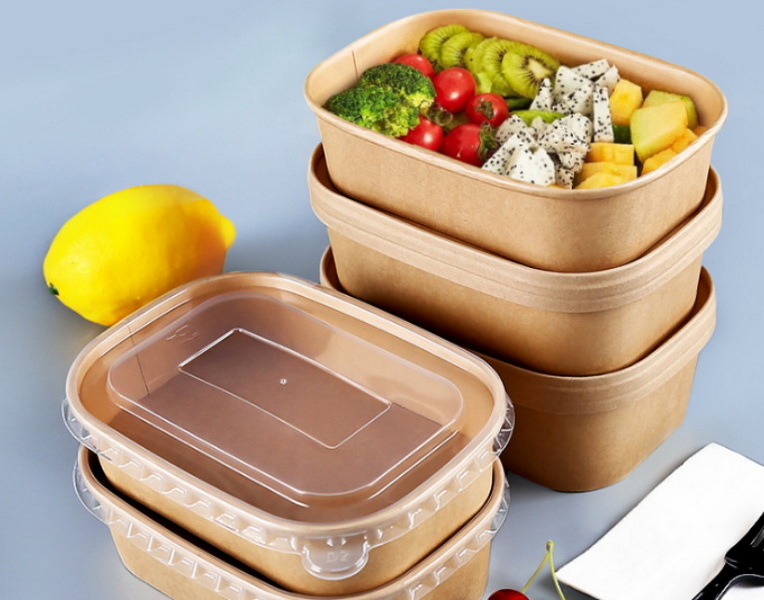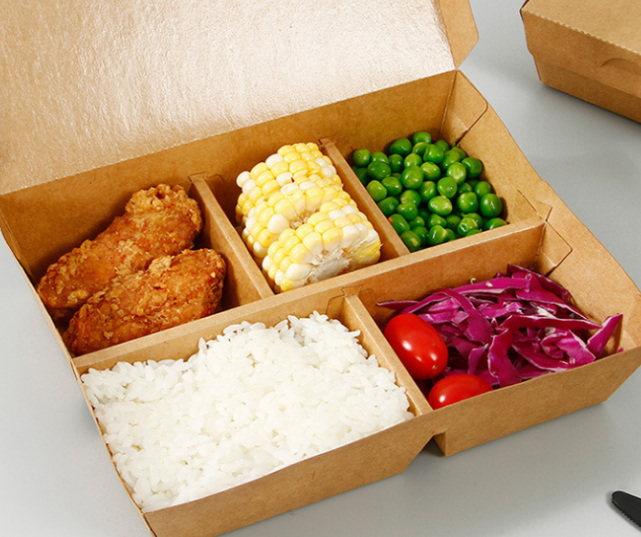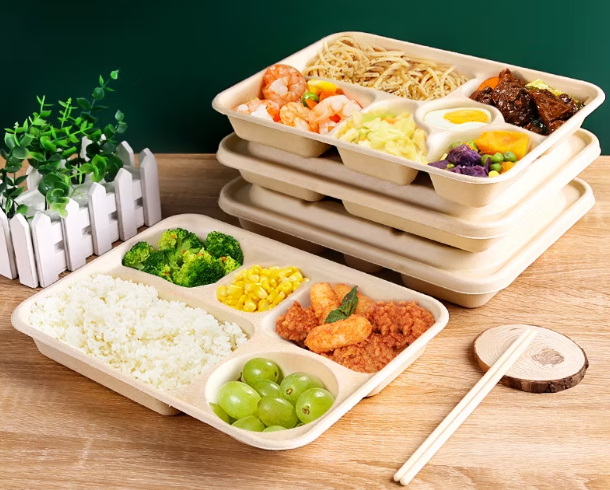
Content Menu
● Introduction
● The Environmental Impact of Plastic Lunch Boxes
>> Plastic Waste Accumulation
>> Harm to Wildlife
>> Greenhouse Gas Emissions
● What Are Biodegradable Disposable Lunch Boxes?
>> Common Materials Used
>> How They Decompose
● Key Benefits of Biodegradable Disposable Lunch Boxes
>> Eco-Friendly Decomposition
>> Reduction in Plastic Pollution
>> Resource Efficiency
>> Composting and Soil Health
>> Lower Carbon Footprint
● Health and Safety Considerations
>> Chemical-Free Packaging
>> Allergen Awareness
>> Food Safety
● Economic and Social Benefits
>> Supporting Green Industries
>> Enhanced Brand Image
>> Compliance with Regulations
● Practical Advantages in Everyday Use
>> Convenience
>> Versatility
>> Strength and Durability
>> Aesthetic Appeal
● Challenges and Limitations of Biodegradable Disposable Lunch Boxes
>> Cost Considerations
>> Composting Infrastructure
>> Consumer Awareness
>> Performance Limitations
● How to Choose the Right Biodegradable Disposable Lunch Box
>> Material
>> Certification
>> Size and Shape
>> Supplier Reputation
>> End-of-Life Options
● Conclusion
● FAQ
>> 1. What materials are commonly used to make biodegradable disposable lunch boxes?
>> 2. How long does it take for a biodegradable disposable lunch box to decompose?
>> 3. Are biodegradable disposable lunch boxes safe for hot and cold foods?
>> 4. Can biodegradable disposable lunch boxes be recycled?
>> 5. Are biodegradable disposable lunch boxes more expensive than plastic?
In a world increasingly concerned with environmental sustainability, our everyday choices matter more than ever. One such choice is the type of lunch box we use. While plastic lunch boxes have dominated the market for decades due to their convenience and low cost, the tide is turning. More individuals, businesses, and institutions are now opting for biodegradable disposable lunch boxes as a responsible alternative. But why is this shift happening, and what makes biodegradable options superior to traditional plastic? In this comprehensive article, we will explore the compelling reasons to choose biodegradable disposable lunch boxes over plastic, delving into their environmental, health, economic, and practical benefits.

Introduction
The global plastic crisis is no longer a distant threat—it's a reality that affects every corner of our planet. From the deepest oceans to the highest mountains, plastic waste is omnipresent. As awareness grows, so does the demand for sustainable alternatives. Among these, the biodegradable disposable lunch box stands out as a simple yet powerful tool for reducing our ecological footprint. This article will guide you through the reasons why switching to biodegradable lunch boxes is not just a trend, but a necessity for a sustainable future.
The Environmental Impact of Plastic Lunch Boxes
Plastic lunch boxes, while convenient, have a devastating impact on the environment. Most are made from petroleum-based polymers, which take hundreds of years to break down. During this time, they release harmful chemicals into soil and water, endanger wildlife, and contribute to the ever-growing problem of microplastics.
Plastic Waste Accumulation
Every year, billions of plastic containers are discarded after a single use. Many of these end up in landfills, waterways, and oceans, where they persist for generations. The durability that makes plastic so useful is also what makes it so dangerous to the environment.
Harm to Wildlife
Plastic debris is often mistaken for food by animals, leading to ingestion, entanglement, and often death. Microplastics have been found in the bodies of marine life, birds, and even humans, raising concerns about health effects across the food chain.
Greenhouse Gas Emissions
The production and disposal of plastic lunch boxes contribute significantly to greenhouse gas emissions. From extracting fossil fuels to manufacturing and incineration, every stage of the plastic lifecycle releases carbon dioxide and other pollutants.
What Are Biodegradable Disposable Lunch Boxes?
Biodegradable disposable lunch boxes are containers designed for single-use food packaging, made from natural materials that break down quickly and safely in the environment. Unlike plastic, which can persist for centuries, biodegradable materials decompose within months under the right conditions, returning nutrients to the soil without leaving toxic residues.
Common Materials Used
- Bagasse (Sugarcane Fiber): A byproduct of sugar production, bagasse is sturdy, heat-resistant, and compostable.
- Cornstarch: Derived from corn, this material is lightweight and breaks down easily.
- Wheat Bran: Used for its strength and biodegradability.
- Bamboo: A fast-growing, renewable resource that is both durable and eco-friendly.
- Palm Leaves: Naturally fallen leaves are molded into containers, requiring minimal processing.
How They Decompose
Biodegradable lunch boxes are designed to break down through natural processes involving microorganisms, moisture, and oxygen. In industrial composting facilities, they can decompose within weeks. Even in home composting setups, they degrade far more rapidly than plastic.

Key Benefits of Biodegradable Disposable Lunch Boxes
Switching to biodegradable disposable lunch boxes offers a multitude of advantages for individuals, businesses, and the planet.
Eco-Friendly Decomposition
Perhaps the most significant benefit is their ability to decompose naturally. When disposed of properly, these lunch boxes break down into harmless organic matter, enriching the soil rather than polluting it.
Reduction in Plastic Pollution
By replacing plastic with biodegradable alternatives, we can drastically reduce the amount of plastic waste entering landfills and oceans. This helps protect wildlife, preserve natural habitats, and maintain cleaner communities.
Resource Efficiency
Many biodegradable lunch boxes are made from agricultural byproducts that would otherwise go to waste. This not only reduces the demand for virgin resources but also adds value to existing supply chains.
Composting and Soil Health
When composted, biodegradable lunch boxes return valuable nutrients to the soil, improving its fertility and structure. This supports sustainable agriculture and reduces the need for chemical fertilizers.
Lower Carbon Footprint
The production of biodegradable materials typically requires less energy and generates fewer greenhouse gases than plastic manufacturing. By choosing these alternatives, we can help mitigate climate change.
Health and Safety Considerations
The benefits of biodegradable disposable lunch boxes extend beyond the environment—they also offer important health advantages.
Chemical-Free Packaging
Unlike some plastics, which can leach harmful chemicals like BPA and phthalates into food, biodegradable lunch boxes are generally free from toxic additives. This makes them a safer choice for both adults and children.
Allergen Awareness
Many biodegradable options are made from hypoallergenic materials, reducing the risk of allergic reactions. Always check product labels if you have specific sensitivities.
Food Safety
Biodegradable containers are designed to withstand hot and cold foods without breaking down prematurely. They are also less likely to harbor bacteria compared to reusable plastic containers that are not properly cleaned.
Economic and Social Benefits
While the initial cost of biodegradable disposable lunch boxes may be slightly higher than plastic, the long-term economic and social benefits are substantial.
Supporting Green Industries
By choosing biodegradable products, consumers and businesses help drive demand for sustainable materials, supporting innovation and job creation in the green sector.
Enhanced Brand Image
For businesses, switching to biodegradable packaging demonstrates a commitment to environmental responsibility. This can enhance brand reputation, attract eco-conscious customers, and differentiate products in a crowded market.
Compliance with Regulations
As governments worldwide implement stricter regulations on single-use plastics, adopting biodegradable alternatives can help businesses stay ahead of the curve and avoid potential fines or penalties.
Practical Advantages in Everyday Use
Beyond environmental and health considerations, biodegradable disposable lunch boxes offer practical benefits that make them an attractive choice for daily life.
Convenience
Like their plastic counterparts, biodegradable lunch boxes are lightweight, stackable, and easy to transport. They are ideal for picnics, takeout, catering, and school lunches.
Versatility
Available in a variety of shapes and sizes, biodegradable lunch boxes can accommodate everything from salads to soups to sandwiches. Many are microwave and freezer safe, adding to their versatility.
Strength and Durability
Modern manufacturing techniques have made biodegradable lunch boxes just as sturdy as plastic, capable of holding hot, cold, or greasy foods without leaking or collapsing.
Aesthetic Appeal
Natural materials often have a unique, rustic look that appeals to consumers seeking authenticity and simplicity.

Challenges and Limitations of Biodegradable Disposable Lunch Boxes
While the advantages are clear, it's important to acknowledge the challenges associated with biodegradable disposable lunch boxes.
Cost Considerations
Biodegradable materials can be more expensive to produce than plastic, leading to higher retail prices. However, as demand increases and technology advances, these costs are expected to decrease.
Composting Infrastructure
Effective decomposition often requires access to industrial composting facilities, which may not be available in all areas. Some materials may not break down as quickly in home composting setups.
Consumer Awareness
Not all consumers are aware of how to properly dispose of biodegradable lunch boxes, leading to contamination in recycling streams or landfill waste.
Performance Limitations
While most biodegradable containers are sturdy, some may not perform as well as plastic in extreme conditions, such as prolonged exposure to moisture or heavy weights.
How to Choose the Right Biodegradable Disposable Lunch Box
With so many options on the market, selecting the best biodegradable disposable lunch box can be overwhelming. Here are some factors to consider:
Material
Choose a material that suits your needs—bagasse for heat resistance, bamboo for durability, or cornstarch for lightweight convenience.
Certification
Look for certifications such as ASTM D6400 or EN 13432, which indicate that the product meets recognized standards for compostability.
Size and Shape
Select containers that match the types of food you typically pack. Some brands offer compartmentalized options for meals with multiple components.
Supplier Reputation
Purchase from reputable suppliers who are transparent about their sourcing and manufacturing practices.
End-of-Life Options
Consider how the lunch box will be disposed of after use. If you have access to composting facilities, choose products designed for industrial composting.
Conclusion
The choice between plastic and biodegradable disposable lunch boxes is more than a matter of convenience—it's a decision that impacts the health of our planet and future generations. By making the switch, we can reduce plastic pollution, support sustainable industries, and protect our health. While challenges remain, the benefits of biodegradable lunch boxes far outweigh the drawbacks. As consumers, businesses, and communities, we have the power to drive positive change through the choices we make every day.

FAQ
1. What materials are commonly used to make biodegradable disposable lunch boxes?
Biodegradable disposable lunch boxes are typically made from natural materials such as bagasse (sugarcane fiber), cornstarch, bamboo, wheat bran, and palm leaves. These materials are chosen for their ability to break down quickly and safely in the environment.
2. How long does it take for a biodegradable disposable lunch box to decompose?
The decomposition time depends on the material and the composting conditions. In industrial composting facilities, most biodegradable lunch boxes break down within 60-90 days. In home composting setups, the process may take a bit longer, but it is still significantly faster than plastic.
3. Are biodegradable disposable lunch boxes safe for hot and cold foods?
Yes, most biodegradable lunch boxes are designed to withstand a range of temperatures. Bagasse and bamboo containers, in particular, are heat-resistant and suitable for both hot and cold foods. Always check the manufacturer's guidelines for specific temperature limits.
4. Can biodegradable disposable lunch boxes be recycled?
Biodegradable lunch boxes are generally intended for composting rather than recycling. Mixing them with traditional recyclables can contaminate the recycling stream. It's best to dispose of them in compost bins or facilities designed for organic waste.
5. Are biodegradable disposable lunch boxes more expensive than plastic?
While biodegradable lunch boxes can be slightly more expensive than plastic due to higher production costs, the price gap is narrowing as demand increases and manufacturing processes improve. The long-term environmental and health benefits often justify the additional cost.


















